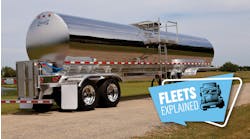Tire engineers are quick to extol the virtues of testing new designs in the lab using calibrated test fixtures, including dynamometer wheels. Others argue that real world service conditions are the ultimate proving ground. But since tires operate under widely varying climates and service conditions, it's difficult to compare performance levels. What's needed is a more uniform operating environment.
One solution is to use a steel surfaced test wheel, called a dynamometer test fixture, located in a climate-controlled laboratory. The government requires all highway tires sold in the U.S. and Canada to be tested using these setups.
Large diameter (67.25 in.) smooth steel wheels are used for these tests, as well as for evaluating rolling resistance. Still larger wheels (about 120 in. in diameter) are used for longer term tread and casing durability testing. Most of these test procedures have been correlated to real-world performance.
Since tires are designed to operate on flat roadway surfaces, correction factors are often used to extrapolate performance on the curved surface of the laboratory test wheels to the flat road surface. As a general rule, the smaller the test wheel, the larger the correction factor. At some point, the tire is deflected so severely under load that performance on the small test wheel no longer resembles performance on road surfaces.
Tire problems are sometimes created when trucks are operated for longer than very brief periods on small-diameter dynamometer rolls. The tires are not designed to endure the light-load/high-torque transfer concentrations and reverse curvature in the tread area imparted by some chassis dynamometer conditions. This can lead to excessive heat buildup in the tire crown just under the tread center. And in extreme cases, the rubber compounds actually revert creating a tunnel that extends around the tire. This is more likely to happen on new tires with deep treads than on well-used tires. Drive tire designs often fare worse than rib steers or trailer tires.
All major tire manufacturers have recommended guidelines that should be followed when running a truck on a chassis dynamometer. Guidelines from a review of literature published by several manufacturers include the following:
-
Bigger dyno rolls are better from a tire durability standpoint;
-
Shallow tread tires are preferred to deeper tread tires
-
Used tires are preferred to new tires;
-
Limit dyno “on time” to the minimum necessary to perform the necessary tests;
-
Allow one- to two-hour cool-down time between tests;
-
Use dedicated tires for tests of longer duration;
-
Limit high-torque test conditions to the minimum necessary.
Some engineers indicate that it may be desirable to adjust inflation pressures downward to minimize the potential for tire damage when running on a chassis dyno. However, they are reluctant to recommend this without complete assurance that proper operating inflation be restored before the vehicle is returned to regular service.
The Technology and Maintenance Council publishes an illustrated “Radial Tire Conditions Analysis Guide”' that is very comprehensive. To order one, call TMC at 703-838-1763.
Before you run a truck equipped with regular-service tires on a chassis dyno, consult a reliable tire industry engineer or technician for advice. This could save you the money and headache of tire casing damage, which is especially a concern with today's long mileage and retreadable radials.


